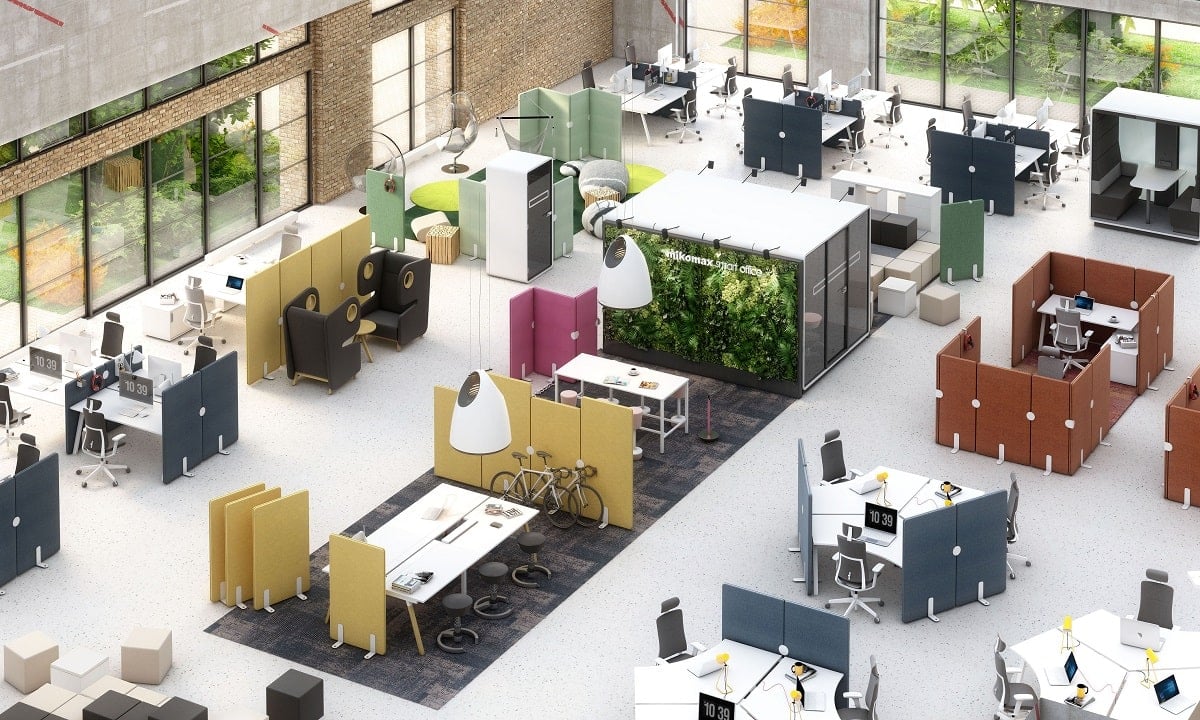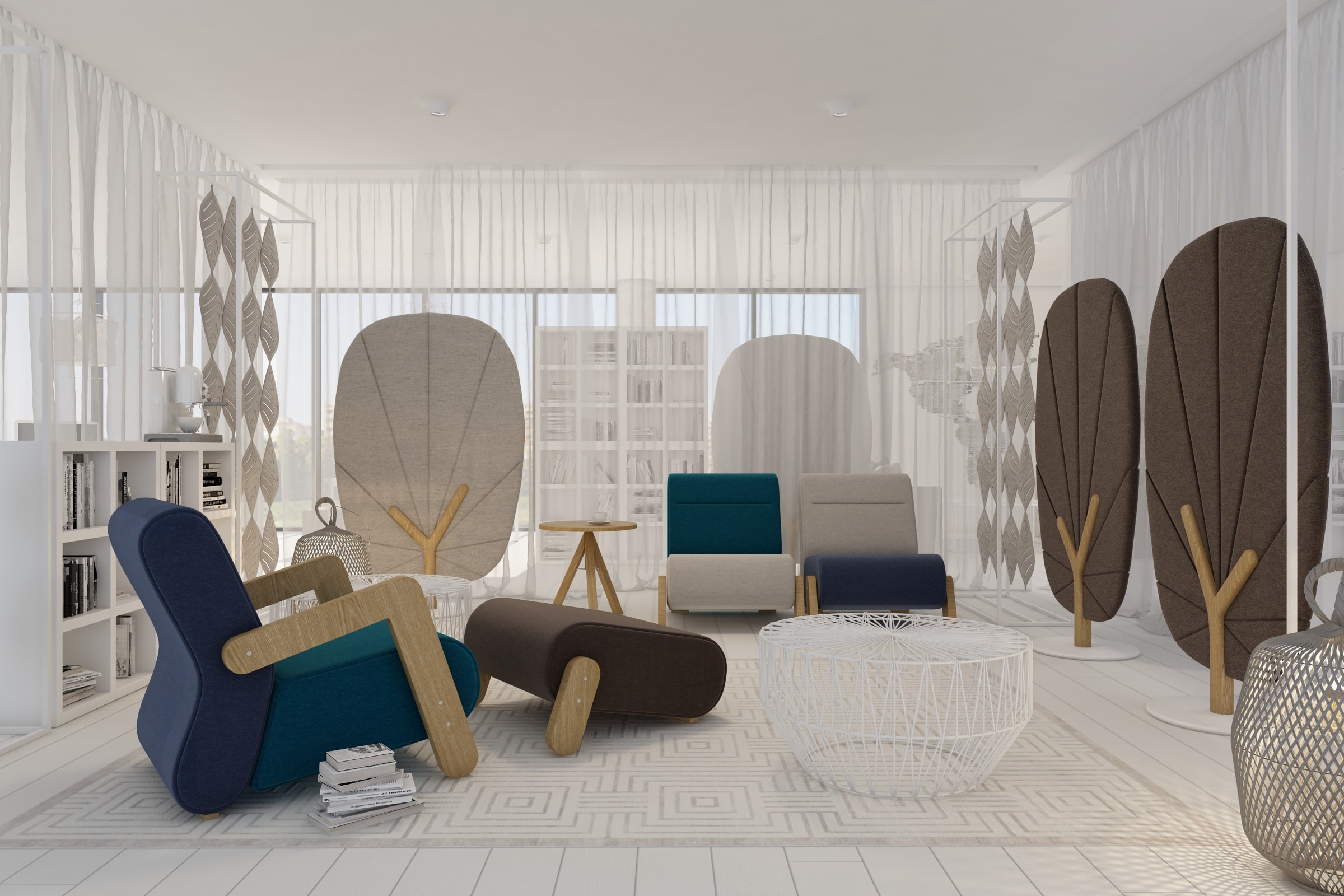What makes a workplace the dream office?

The office requirements of today’s employees are quite similar regardless of the company’s activities. In the hybrid working model, which became very popular after the Covid-19 pandemic, flexible workplaces have become necessary, providing comfort while employees perform a variety of tasks individually and in teams. The modern office is no longer just a place with tables, desks and chairs, but a space that encourages creativity and the sharing of ideas, and provides comfort during work and relaxation. In this article, we take a look at what workplace types are currently trending and what elements make the workplace a dream office.
From coffee shops to coworking spaces – the evolution of offices in the 21st century
Thinking about offices and forms of employment has been completely revolutionised by the pandemic. Fully remote or hybrid working has become the norm. Although the situation has now returned to normal, employees’ expectations of office space have changed significantly. They prefer to carry out their professional duties partly at home, while they come to the office to meet colleagues and clients, and to talk about new projects. The flexible hybrid office becomes a place for collaboration, socialising, group work and inspiring new ideas. This approach introduces new trends, including the popularity of coworking spaces.
Modern office arrangements are based on communal spaces, reminiscent of cafés with relaxation zones and creative work areas. Soft seating does not necessarily have to look like it was designed for an office. Upholstered Packman sofas, which look like the hero of a popular game, go beyond the generally accepted patterns – they are designer models that could just as well complement the décor of a café, restaurant or home. They will work well for business conversations as well as inspirational talks.
Offices of the future – what trends await us in the coming years?
We can expect to see more changes in office space design in the coming years. Offices will evolve to accommodate the changing needs of employees and technology. Companies that want to retain and attract talent will need to keep up with these changes. Here are some of the trends we can currently observe:
Combination of remote and office work
The global pandemic has contributed to the spread of the hybrid working model. Previously, only a few employees, such as those in the IT sector, were privileged enough to perform their duties remotely. Nowadays, when looking for work, many people choose companies that will allow them to work flexibly from anywhere. According to research conducted for the State of Hybrid Work report, up to 67% of people questioned do not want to return to the office full time.
According to the expert
Despite these changes, employees still need offices where they can meet other people, work in groups or discuss their ideas with colleagues. Flexibility at work also applies to the availability of attractive office space that accommodates a variety of needs. In flexible hybrid offices, the employee will find areas for quiet work, areas for conceptual work, group work, video conferencing with colleagues outside the company, and areas for relaxation and informal conversations. This approach gives employees flexibility and access to the office when they need it
– says Eliza Donek, Product Manager at Mikomax.
The human-centric concept of dream office
The modern worker needs a space that suits his or her requirements. If they prefer to work standing up instead of sitting for hours at a desk, they should be allowed to do so through investment in ergonomic adjustable desks. According to the important concept of a human-centric office, the office space should take into account the natural, physical and psychological needs of staff.
Every company wants the best employees in the market to join its ranks and wants them to stay for the long term, not only because of the right financial conditions, but also because it is a friendly workplace. Organisations need to move towards a model based on flexibility, empathetic management and attention to employee well-being. The human-centric office concept is that contemporary office spaces will provide comfort, ergonomics and adequate acoustics as well as access to natural light.
Offices that are closer to nature
Another important element of modern offices responding to the requirements of employees is greater integration with nature. Plants help to create a space that reduces stress, gives a sense of security and harmony with nature, and improves well-being. Biophilic design is the future of office interior design. Plants, fountains and outdoor areas such as terraces and balconies with flowers are extremely important features. Working in such an environment improves the well-being and creativity of employees. In addition to their aesthetic value, green walls, and flowers on desks and other furniture help to maintain air quality and create a healthy environment within the company.
Dynamic spaces, adapted to changing needs
The modern worker needs a space that adapts to their changing needs and way of working. Few people nowadays perform duties for 8 hours only sitting at a desk. Telephone calls, video conferencing and team meetings require a suitable venue to enhance the comfort of these activities. This is why more and more offices are introducing dynamic spaces, i.e. spaces that can be easily adapted for different purposes. Furniture such as the Ligo modular cube system or the Balance electronically adjustable desks, depending on the setting, allow for different work configurations, e.g. team brainstorming, discussion of key points in a project and individual focused work. Employee needs are flexible, so multifunctional solutions are required.
Offices as places for creative work
Today’s offices increasingly place emphasis on creating an environment that fosters creativity and innovative ideas. However, it is difficult to focus, develop your skills and work on a project in an open space. The solution is Soniq mobile acoustic wall systems, which enhance comfort. They fit perfectly into the concept of a dynamic space, providing bespoke workstation arrangement possibilities. The wide range of sizes allows you to easily and comfortably create a space in which to work individually or discuss a matter with a teammate without disturbing others.
Future-proof your office and provide ergonomic workstations for employees
See our desks for open spaces >>
Hot-desking, open space, executive offices – what elements of dream office attract employees?
Employees from generations Y and Z are increasingly taking into account the design of their office space when considering a job offer. An attractive benefits package and salary are no longer enough to attract the best talent to a company. Although open-plan spaces still dominate organisations, they are now divided into zones. Increasingly, hot desks are appearing in hybrid offices, while the office model still works well in some companies. Unfortunately, there is no single office design that works for every company. An analysis of staff needs will help in selecting the right space plan to provide a safe, comfortable working environment.
Almost at home in the office
Today, the boundary between working from home and in the office has been heavily blurred. It should therefore come as no surprise that many employees expect the workplace to resemble a domestic interior. They want to feel comfortable and at ease and have access to a variety of amenities. Such spaces should offer comfortable sofas, soft armchairs and a kitchen or food preparation area. Decorative elements such as carpets or paintings are also often introduced to create a pleasant atmosphere that promotes contact between employees.
Privacy and acoustic comfort
Open space often lacks privacy and silence, which has a negative impact on work efficiency. This is why more and more offices are introducing solutions that allow for easy separation from other jobs. These can include office walls, acoustic mats, acoustic panels and acoustic booths. An interesting proposition is the free-standing acoustic walls in the shape of a tree, the placement of which in open space will bring the park into the office. They help to muffle sounds, shield workstations and provide some privacy.

The right space for online meetings
In the age of hybrid working, more and more meetings are taking place online. It is therefore important for offices to have adequate space for this purpose. These can include meeting rooms equipped with audio and video equipment, as well as coworking areas with dedicated video conferencing workstations.
Chillout rooms and games rooms – areas for relaxation and relationship building
Employees also need places where they can rest and relax while working on a project. Such spaces should be equipped with soft sofas and armchairs, as well as games and multimedia to foster integration and build relationships between employees.
Modern technology makes a difference
Today’s offices should be equipped with modern technology to facilitate work and ensure efficiency. These can include project management tools, room or desk booking applications or video conferencing tools.
In summary, the evolution of workplaces has led to more flexible, creative and sustainable dream offices that take into account the needs of different professional groups and respond to the challenges of the modern world. As employees’ expectations grow, office spaces must also adapt, offering new solutions and providing a higher level of service. We can therefore expect further developments in the office market in the near future.
Eye-catching design and exceptional comfort – this is the kind of office furniture that employees seek in dream offices
See our collection of hybrid office furniture and choose the best items for your business >>
